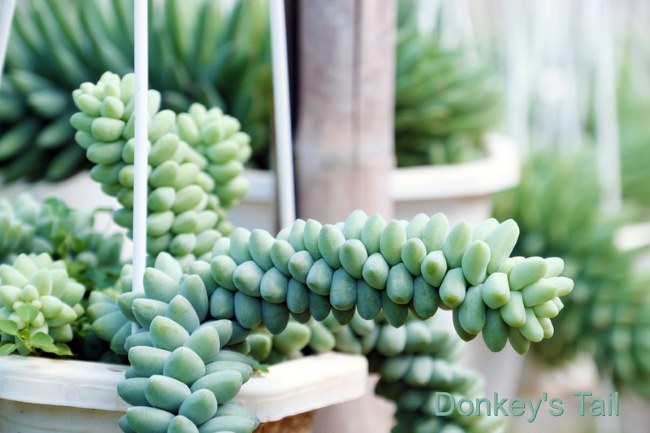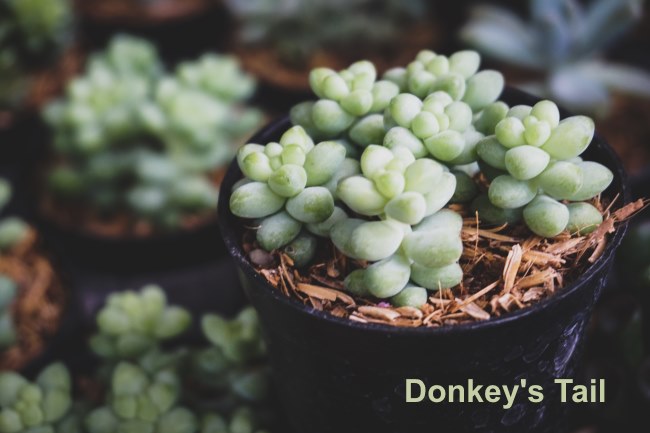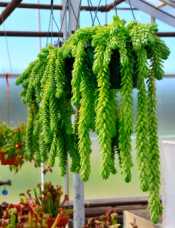Donkey's Tail
Botanical Name: Sedum morganianum
Donkey's Tail -- sometimes called Burro's Tail -- is a succulent with stems thickly covered with overlapping, plump, blue-green leaves that trail down the side of its container.
 This trailing succulent plant is ideal for a hanging basket. Photo ©Hoxuanhuong
This trailing succulent plant is ideal for a hanging basket. Photo ©HoxuanhuongSedum Morganianum Solutions and Special Helps
Make it bloom. Although it rarely blooms indoors, small flowers of pink or red may appear at the tips of its stems in the summer. Give Donkey's Tail plant bright light during the growing season, spring through fall. Bright light in the summer and a cool rest in the winter will help promote blooming.
Shed some light. Give this evergreen succulent plenty of bright light. If you move it outside in summer, put it in a shaded spot because it sunburns easily if suddenly exposed to full sun.
Give it a winter rest. Keep Sedum morganianum slightly cooler in winter, with a minimum of 55°F/13°C. Stop fertilizing in fall and winter and water sparingly during this rest.
Shriveled, wrinkled leaves are a sign that this succulent needs water.
Repot in spring when the plant fills the pot. You can use a shallow pot -- its roots aren't deep. Move to a pot only 1 size larger, with drainage holes to prevent overwatering.
Handle with care. This plant is so fragile that its leaves will fall off at the slightest touch. It's a good idea to pot it in a hanging basket and leave it alone except for watering and fertilizing.
 Plump, blue-green leaves make Sedum morganianum a captivating houseplant.
Plump, blue-green leaves make Sedum morganianum a captivating houseplant.Did you know...
Donkey's Tail is in the Crassulaceae family, along with other popular, easy-care succulents, including Jade, Kalanchoe and Echeveria.
Buying Tip
You'll usually find these succulents for sale under the Sedum morganianum name. One cultivar 'Burrito' is smaller than the species, with rounder leaves and short stems. It has one big advantage, though -- it's not quite as fragile.
Donkey's Tail Care Tips

Origin: Mexico
Height: Trailing to 2-3 ft (60-90 cm)
Light: Bright light with some direct sun. Shade from strong summer sun.
Water: Keep soil lightly moist in spring and summer. Take care not to saturate the soil when watering Donkey's Tail. Soggy soil will cause the stems to rot at the base. In fall and winter, water sparingly. If leaves appear shriveled, it may be underwatered.
Humidity: Average room (around 40% relative humidity). Will tolerate dry air, but keep plant out of drafts and away from AC/heat vents.
Temperature: Average room temperatures 65-75°F/18-24°C. Give it a cool rest in the winter (55-60°F/13-16°C) to promote blooming the following summer.
Soil: This desert succulent needs a fast-draining mix to prevent stem and root rot. Cactus potting mix works best because it includes horticultural sand.
Fertilizer: Feed monthly spring and summer with a fertilizer specially made for succulents.
Propagation: Succulent cuttings. Take 2-3 in (5-7 cm) stem tip cuttings in spring. Remove the lower leaves to expose the stem and insert it in a mixture of half sharp sand and half peat moss. Keep it moist and be patient -- it can take a couple months. You can also grow from leaf cuttings following the same method.


